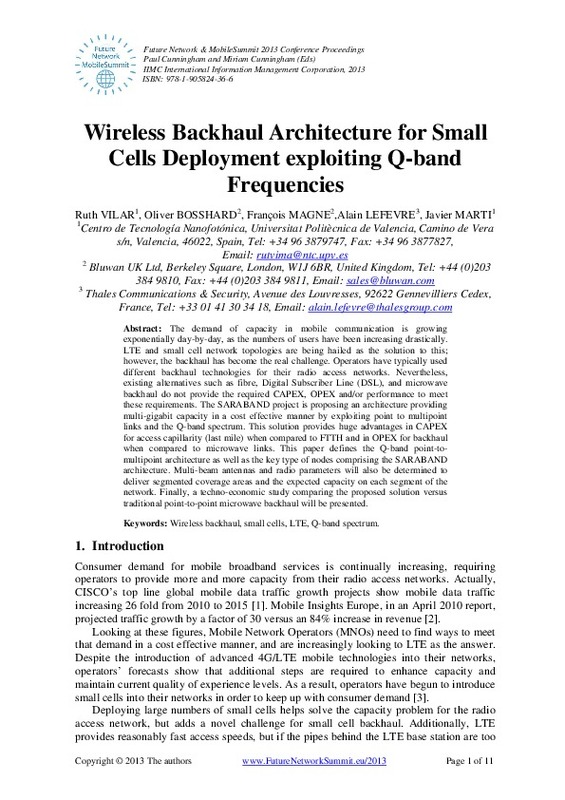JavaScript is disabled for your browser. Some features of this site may not work without it.
Buscar en RiuNet
Listar
Mi cuenta
Estadísticas
Ayuda RiuNet
Admin. UPV
Wireless Backhaul Architecture for Small Cells Deployment exploiting Q-band Frequencies
Mostrar el registro sencillo del ítem
Ficheros en el ítem
| dc.contributor.author | Vilar Mateo, Ruth
|
es_ES |
| dc.contributor.author | Bosshard, Oliver
|
es_ES |
| dc.contributor.author | Magne, François
|
es_ES |
| dc.contributor.author | Le Fevre, Alain
|
es_ES |
| dc.contributor.author | Martí Sendra, Javier
|
es_ES |
| dc.date.accessioned | 2016-04-27T10:46:40Z | |
| dc.date.available | 2016-04-27T10:46:40Z | |
| dc.date.issued | 2013-07-03 | |
| dc.identifier.isbn | 978-1-905824-36-6 | |
| dc.identifier.uri | http://hdl.handle.net/10251/63041 | |
| dc.description.abstract | The demand of capacity in mobile communication is growing exponentially day-by-day, as the numbers of users have been increasing drastically. LTE and small cell network topologies are being hailed as the solution to this; however, the backhaul has become the real challenge. Operators have typically used different backhaul technologies for their radio access networks. Nevertheless, existing alternatives such as fibre, Digital Subscriber Line (DSL), and microwave backhaul do not provide the required CAPEX, OPEX and/or performance to meet these requirements. The SARABAND project is proposing an architecture providing multi-gigabit capacity in a cost effective manner by exploiting point to multipoint links and the Q-band spectrum. This solution provides huge advantages in CAPEX for access capillarity (last mile) when compared to FTTH and in OPEX for backhaul when compared to microwave links. This paper defines the Q-band point-tomultipoint architecture as well as the key type of nodes comprising the SARABAND architecture. Multi-beam antennas and radio parameters will also be determined to deliver segmented coverage areas and the expected capacity on each segment of the network. Finally, a techno-economic study comparing the proposed solution versus traditional point-to-point microwave backhaul will be presented. | es_ES |
| dc.language | Inglés | es_ES |
| dc.publisher | Institute of Electrical and Electronics Engineers (IEEE) | es_ES |
| dc.rights | Reserva de todos los derechos | es_ES |
| dc.subject | Wireless backhaul | es_ES |
| dc.subject | Small Cells | es_ES |
| dc.subject | LTE | es_ES |
| dc.subject | Q-band spectrum | es_ES |
| dc.subject.classification | TEORIA DE LA SEÑAL Y COMUNICACIONES | es_ES |
| dc.title | Wireless Backhaul Architecture for Small Cells Deployment exploiting Q-band Frequencies | es_ES |
| dc.type | Capítulo de libro | es_ES |
| dc.rights.accessRights | Abierto | es_ES |
| dc.contributor.affiliation | Universitat Politècnica de València. Instituto Universitario de Tecnología Nanofotónica - Institut Universitari de Tecnologia Nanofotònica | es_ES |
| dc.description.bibliographicCitation | Vilar Mateo, R.; Bosshard, O.; Magne, F.; Le Fevre, A.; Martí Sendra, J. (2013). Wireless Backhaul Architecture for Small Cells Deployment exploiting Q-band Frequencies. Institute of Electrical and Electronics Engineers (IEEE). 1-11. http://hdl.handle.net/10251/63041 | es_ES |
| dc.description.accrualMethod | S | es_ES |
| dc.relation.publisherversion | http://ieeexplore.ieee.org/document/6633574/ | es_ES |
| dc.description.upvformatpinicio | 1 | es_ES |
| dc.description.upvformatpfin | 11 | es_ES |
| dc.relation.senia | 253957 | es_ES |






